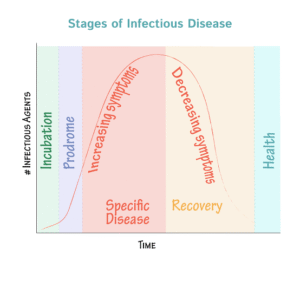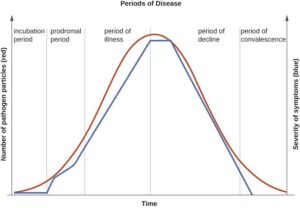Back to: MICROBIOLOGY 300 LEVEL
Welcome to class!
It’s so good to have you back. You’ve been doing a fantastic job staying consistent with your studies, and today’s lesson will help you understand the timeline of how an infectious disease develops in the human body. We’re looking at Phases of Infectious Disease Development. Think of it like watching a stage play—each phase is a scene in the story, from when the microbe first enters the body to when the person recovers or the illness ends.
Phases Of Infectious Disease Development
Understanding these phases will help you recognise what’s happening inside the body during illness, which is key in diagnosis, treatment, and prevention.

What are the Phases of Infectious Disease?
Every infectious disease follows a pattern—a series of stages that occur from the moment the pathogen enters the body until it is cleared or managed. These stages are common across most diseases, although the length of each phase may vary depending on the disease and the person’s immune response.
The main phases are:
1. Incubation Period
This is the silent phase. It starts from the moment the pathogen enters the body to when the first signs and symptoms appear.
There are no visible signs of illness yet, but the microbe is multiplying.

Duration varies: For example, the incubation period for the flu is about 1–4 days, while for HIV, it could be several weeks to months.
The person may still be contagious even without symptoms.
2. Prodromal Stage
This is the warning phase. The person begins to feel “off” or slightly unwell.
Symptoms are not specific and may include tiredness, low-grade fever, or body aches.
This is when the immune system begins to react to the infection.
3. Illness Stage (Acute Phase)
This is the peak of the infection, where symptoms are clear and severe.
The body is in full battle mode.
The type of symptoms depends on the specific disease (e.g., high fever in malaria, coughing in tuberculosis).
Diagnosis is usually made at this stage.
4. Decline Stage
The immune system or medical treatment begins to overpower the pathogen.
Symptoms begin to reduce.
The pathogen’s activity drops.
However, the person may still be vulnerable to secondary infections if care is not taken.
5. Convalescence Stage
This is the recovery phase.

The person begins to regain strength.
Damaged tissues start to heal.
In some cases, the person becomes immune to that specific pathogen (e.g., after chickenpox).
Why These Phases Matter
Understanding these stages helps healthcare workers know when a person is most infectious, when to isolate them, and when to begin or stop treatment. It also helps in health education—teaching people to recognise symptoms early and seek help.
Example: Malaria
Incubation: After a mosquito bite, symptoms may take 7–14 days to appear
Prodromal: General tiredness, slight headache.
Illness: High fever, chills, vomiting, joint pain.
Decline: Symptoms reduce with medication.
Convalescence: Full recovery over a few days or weeks.
Summary
- Infectious diseases develop in five main stages: incubation, prodromal, illness, decline, and convalescence.
- Each phase has distinct features that show the body’s battle against the invading microbe.
- Recognising these stages helps in early treatment, preventing spread, and improving recovery.
Evaluation
- List and briefly explain the five phases of infectious disease development.
- In which phase is the person most contagious?
- Why is the prodromal stage important in early detection of disease?
Each lesson adds to your strength as a future scientist and problem-solver. You’re gaining the tools to protect your community and improve lives. Keep pushing forward with confidence—Afrilearn is right beside you. You’ve got this. See you in the next class!
